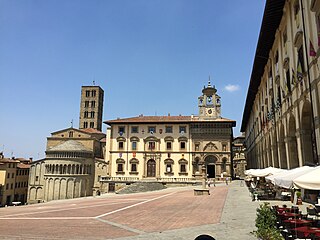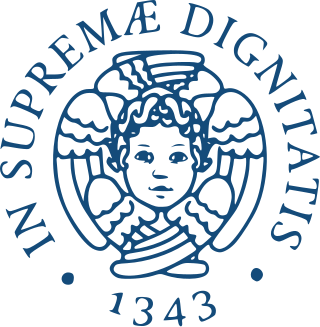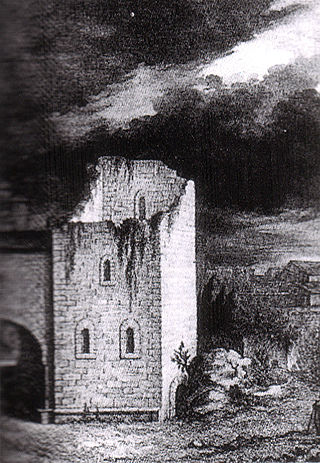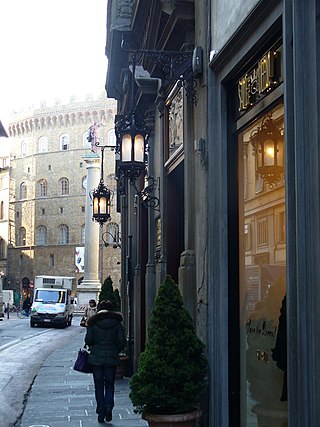
Pisa is a city and comune (municipality) in Tuscany, central Italy, straddling the Arno just before it empties into the Ligurian Sea. It is the capital city of the Province of Pisa. Although Pisa is known worldwide for its leaning tower, the city contains more than twenty other historic churches, several medieval palaces, and bridges across the Arno. Much of the city's architecture was financed from its history as one of the Italian maritime republics.

Arezzo is a city and comune in Italy and the capital of the province of the same name located in Tuscany. Arezzo is about 80 kilometres southeast of Florence at an elevation of 296 metres (971 ft) above sea level. As of 2022, the population was about 97,000.

The University of Pisa is a public research university in Pisa, Italy. Founded in 1343, it is one of the oldest universities in Europe. Together with Scuola Normale Superiore di Pisa and Sant'Anna School of Advanced Studies, it is part of the Pisa University System.

The properties of the Holy See are regulated by the 1929 Lateran Treaty signed with the Kingdom of Italy. Although part of Italian territory, some of them enjoy extraterritoriality similar to those of foreign embassies, including tax exemptions. Nonetheless, those visiting these properties are generally required to follow the immigration rules of Italy. For example, American seminarians at the Pontifical North American College need an Italian visa, despite residing, and studying, in extraterritorial property of the Holy See.

The Palazzo Vecchio is the town hall of Florence, Italy. It overlooks the Piazza della Signoria, which holds a copy of Michelangelo's David statue, and the gallery of statues in the adjacent Loggia dei Lanzi.

The Scuola Normale Superiore in Pisa is a public university institution in Pisa and Florence, Tuscany, Italy, currently attended by about 600 undergraduate and postgraduate (PhD) students. Together with the University of Pisa and Sant'Anna School of Advanced Studies, it is part of the Pisa University System.

Piazza della Signoria is a w-shaped square in front of the Palazzo Vecchio in Florence, Italy. It was named after the Palazzo della Signoria, also called Palazzo Vecchio. It is the main point of the origin and history of the Florentine Republic and still maintains its reputation as the political focus of the city. It is the meeting place of Florentines as well as the numerous tourists, located near Palazzo Vecchio and Piazza del Duomo, and gateway to the Uffizi Gallery.

Pierre Francqueville, generally called Pietro Francavilla, was a Franco-Flemish sculptor trained in Florence, who provided sculpture for Italian and French patrons in the elegant Late Mannerist tradition established by Giambologna.

The Torre dei Gualandi is a former tower in Pisa, central Italy, now included in the Palazzo dell'Orologio.

Palazzo della Carovana is a palace in Knights' Square, Pisa, Italy, presently housing the main building of the Scuola Normale Superiore di Pisa.

The statue of Cosimo I de' Medici stands in the middle of Knights' Square of Pisa, just in front of Palazzo della Carovana.

The Palazzo del Collegio Puteano is a building in Piazza dei Cavalieri in Pisa, Italy. The palace occupies the whole western part of the square and makes a corner with Via Corsica street.

Via de' Tornabuoni, or Via Tornabuoni, is a street at the center of Florence, Italy, that goes from Antinori square to Ponte Santa Trinita, across Santa Trinita square, distinguished by the presence of fashion boutiques.

Jacopo Inghirami was admiral of the Grand Duchy of Tuscany and marquis of Montevitozzo.

Santo Stefano dei Cavalieri is a church in central Pisa located on Piazza dei Cavalieri.

Alessandro Pieroni was an Italian architect and painter. He was active mainly in a Mannerist style, working for the courts of Grandukes Francesco I and Ferdinando I de' Medici, Grand Duke of Tuscany.
The following is a timeline of the history of the city of Pisa in the Tuscany region of Italy.
The following is a timeline of the history of the city of Arezzo in the Tuscany region of Italy.

























